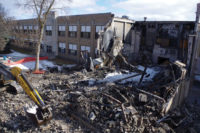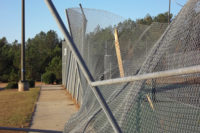Accidental Fire Causes Extensive Restoration in Milwaukee-Area High School
















In the late hours of July 31, 2013 a fire started in the northwest corner of the 25,000-square-foot field house gymnasium at Waukesha North High School and left the 40-year-old Milwaukee-area school devastated with fire, smoke and soot damage. The fire also affected more than 250,000-square-feet of classroom, office and storage areas. The initial cause of the fire was determined to be an accident during the installation of new wood flooring.
The school district’s director of facilities concluded the cleanup would prevent the field house from being complete until after the beginning of the school year, so Jody Landish, Principal at Waukesha North, decided the school had to be closed to all activities for the duration of the cleanup and restoration. The operations staff and teachers at the high school were moved to a local middle school during the process.
J. Murphy, co-owner of Paul Davis National, was notified of the large loss at approximately 8:30 a.m. on Thursday, August 1. On his way to the school he contacted one of the company’s lead project managers to get one of their 53-foot equipment trailers delivered by afternoon. Just 24 hours after the initial devastation, teams from Paul Davis National and Paul Davis Restoration and Remodeling of Southeast Wisconsin arrived on scene with hundreds of crew members and equipment.
The initial fire damage was limited to an area near an exit door in the field house and was extinguished by four local fire departments, but damage from the large volume of smoke and soot affected the field house, classrooms and hallways. There was minimal structural damage because the fire occurred in an area where there was steel, but 130 square feet of hard wood floor, and the rubberized floor underneath, were damaged.
Restoration work and repairs included removal and replacement of all porous ceiling tiles throughout the building along with a thorough cleaning of all materials such as drywall, carpeting, cabinets, wood paneling and base molding which came into contact with the fire, smoke or soot. Some electrical and mechanical equipment was replaced and the heating, ventilation and air conditioning (HVAC) unit was cleaned. At project completion, the team cleaned, deodorized and sterilized the entire building.
Additional repairs included re-striping the intricate gym floor, removing, cleaning and re-hanging the sports activities and athletic award banners and also replacing the color coordinated bleachers, which had to be specially-ordered.
During the job, all procedures were completed at the customer’s direction and approvals were reviewed by the high school staff, school district officials and the insurance carriers. Paul Davis and all other parties worked together to secure the project, develop the scope of work, execute the plan document and the progress, and calculated costs. Murphy made sure the process remained fluid and flexible to flow with the customer’s requests, and his key objective was to present suitable options and make informed decisions.
In addition to the national and local general contractors, highly-specialized technicians in property damage emergency services and restoration arrived at the job each day and split up into two 12-hour shifts. Tractor trailers housed the equipment and were kept on-site. Portable air conditioning, hydroxyl generators, air movers, power generators and contents processing equipment were all present on-site and were used to stabilize interior environments.
To further organize what was a complex large loss, Murphy developed a job uniform coordination system with crews wearing three different types of colored shirts to signify the specific work for project managers, supervisors, technicians and general labor. For organizational purposes, the customer and the stakeholders were made aware of the color distinctions. Daily meetings were held at 11 a.m. and served as a general call to all stakeholders and attendees, including Paul Davis, Principal Landish, on-site school administration, the school board faculty, the insurance company and other workers involved in the project.
Murphy also maintained organization among all crews via a multi-colored floor map which represented job progress by grid. For example, the system would ensure the demolition crews removed ceiling tiles in a certain area with systematic duct cleaning and then replaced the tiles. This allowed the electrical and structural cleaning crew chiefs to make modifications to the floor plan and continue their work.
Additionally, tool box safety meetings were held throughout the process prior to each shift for workers and supervisors. The meetings informed them of safety topics, current conditions and crew assignments. Customers were also present at the meetings to share their needs and concerns.
“This was a challenging project, however hourly and daily increments were planned to assess the damage and the work required to get the project done on time,” said Murphy. “To add to complexity, we had to contain and control the microbial growth right away. We established a healthy and safe environment for the buildings’ ongoing use as a public school.”
Due to the importance of establishing a 100% clean environment, a significant remediation effort was mandatory. This aspect of the project included specific work such as removing and replacing all ceiling tiles, replacing all insulated ducts and the flex duct and also cleaning the interior structure and contents throughout the entire 250,000-square-foot building. The job cost grew from an initial fire department projection of $300,000 in damages to approximately $6.2 million.
“These types of losses are unpredictable and the response strategy must be managed with critical and immediate action,” said Murphy. “(We have) a tremendous advantage in this arena due to our extensive experience. Documentation must be delivered in an accurate and timely manner to ensure efficient cost containment. Our primary objective is to operate all loss sites efficiently by establishing in writing, its proposed tactics and techniques in advance of implementation.”
The multi-million dollar emergency services project was completed by the deadline of August 24 and allowed 80 teachers to re-enter the school for early planning days, followed by 1,156 students to begin classes on September 3.
Looking for a reprint of this article?
From high-res PDFs to custom plaques, order your copy today!












